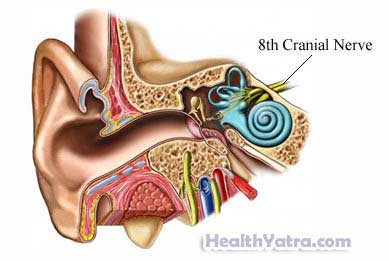সংজ্ঞা
A cochlear implant is an electronic device that is implanted during surgery. It helps provide hearing to people who have a certain type of hearing loss. This type of hearing loss is usually caused by damage or a defect in the inner ear. The implants can directly stimulate the auditory nerve to send information to the brain.
Cochlear implants have three parts:
- Speech processor—The speech processor looks like a long, narrow calculator. It is worn behind the ear or on a belt. It increases sound, converts it into digital signals, and sends these signals to the transmitter.
- Transmitter—The transmitter is a headphone that is worn behind the ear. It receives electrical signals from the speech processor and sends them through the skin to the receiver.
- Receiver—The receiver is the part that is implanted. It is a magnetic disk about the size of a quarter. It is placed under the skin behind one ear. A wire that runs from the receiver to an electrode is placed in the inner ear, where it stimulates the acoustic nerve.

পদ্ধতির কারণ
Cochlear implants provide a heightened sense of sound for adults and children with profound hearing loss. They are designed for people whose hearing does not improve with surgical correction or the use of a hearing aid. Cochlear implants will not restore or create normal hearing.
সম্ভাব্য জটিলতা
If you are planning to have an implant, your doctor will review a list of possible complications, which may include:
- সংক্রমণ
- Damage to nearby nerves
- Problems with balance
- Emotional stress caused by having higher expectations for the technology
- Poor quality of hearing following the surgery
জটিলতার ঝুঁকি বাড়াতে পারে এমন কিছু কারণের মধ্যে রয়েছে:
- ধূমপান
- আগের অস্ত্রোপচার
- Previous ear infections
- Abnormal anatomy
কি আশা করছ
পদ্ধতির আগে
Your doctor may do some or all of the following.
- Your doctor will examine you, paying particular attention to your ears. This can be done with:
- A medical history and physical exam
- Ear exam
- Hearing evaluation
- Psychological evaluation
- Your doctor may need pictures of your ear. This can be done with:
- এমআরআই
- সিটি স্ক্যান
- You should be up-to-date on immunizations. Pneumococcal, meningococcal, andhaemophilus vaccines are especially important. There has been a link between cochlear implants and bacterial meningitis.
আপনার পদ্ধতি পর্যন্ত নেতৃত্ব:
- আপনার ওষুধ সম্পর্কে আপনার ডাক্তারের সঙ্গে কথা বলুন। পদ্ধতির এক সপ্তাহ আগে আপনাকে কিছু ওষুধ খাওয়া বন্ধ করতে বলা হতে পারে, যেমন:
- অ্যাসপিরিন বা অন্যান্য প্রদাহ বিরোধী ওষুধ
- রক্ত পাতলাকারী, যেমন ক্লোপিডোগ্রেল বা ওয়ারফারিন
- পদ্ধতিতে এবং থেকে একটি যাত্রার ব্যবস্থা করুন।
- আগের রাতে হালকা খাবার খান। খাওয়া বা মধ্যরাত্রি পরে কিছু পান করবেন না।
এনেস্থেশিয়া
General anesthesia is used for this procedure. You will be asleep.
পদ্ধতির বর্ণনা
There are two parts to the procedure:
- Implantation of receiver—A cut will be made in the skin behind the ear. A hole will be drilled through the bone behind the ear to the cochlea. A wire will be placed through the hole and into the cochlea. The receiver will then be put against the bone behind your ear. The wire will be attached to the receiver. The incision will be closed with stitches.
- External hook-up—In 4 to 6 weeks, the area should be healed. At this point, the transmitter headpiece and speech processor will be hooked up.
এতে কতক্ষণ সময় লাগবে?
About 1½-2 hours for adults and up to five hours for children
এটা কতটা আঘাত করবে?
Anesthesia prevents pain during the procedure. You will have some pain after. Your doctor can give you medicine to help manage any pain.
গড় হাসপাতালে থাকার
The length of stay depends on the reasons why you are having the implant. Speak to your doctor about how long your stay may be.
পোস্ট-প্রক্রিয়া যত্ন
ঘরে
After your procedure, be sure to follow your doctor’s instructions. Ask your doctor about when it is safe to shower, bathe, or soak in water.
You will have frequent follow-up visits for the following:
- Headpiece fitting, done 4-6 weeks after surgery
- Adjustments to the speech processor
- Ongoing evaluation of hearing status
In addition, you will have cochlear implant training. This will help improve your ability to:
- Identify sounds
- Read lips
- Develop speech skills
আপনার ডাক্তারকে কল করুন
আপনি হাসপাতাল ছেড়ে যাওয়ার পরে, নিম্নলিখিতগুলির মধ্যে যেকোনটি ঘটলে আপনার ডাক্তারের সাথে যোগাযোগ করুন:
- ব্যাথা
- Dizziness or vomiting
- Facial paralysis or twitching
- জ্বর এবং ঠাণ্ডা সহ সংক্রমণের লক্ষণ
- লালভাব, ফোলাভাব, ক্রমবর্ধমান ব্যথা, অত্যধিক রক্তপাত, বা ছেদ স্থানে স্রাব
- Cough, shortness or breath, chest pain, or severe nausea or vomiting
জরুরী পরিস্থিতিতে, অবিলম্বে চিকিৎসা সহায়তার জন্য কল করুন।
